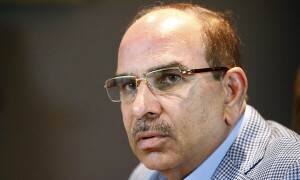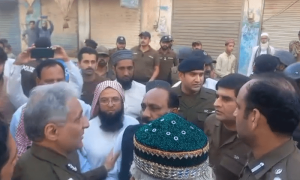On a fairly hot and humid July morning, driving through the oak-lined, winding streets of the museum district of Houston, we headed for the Rothko Chapel. In 1971, Houston art collectors cum oil-barons cum philanthropists, John and Dominique de Menil who founded the Chapel, must have known on the spot that Houston was the perfect city for an intimate sanctuary for people of various beliefs. Being the melting pot of the melting pot, Houston is home to people of all ethnicities with their own little unofficially designated areas strewn all over the sprawling city.
Surrounded by pretentious but lush lawns, stands the dark, stark, octagonal Rothko Chapel. It faces Barnett Newman’s enigmatic sculpture, the Broken Obelisk, which is poised above a long, shallow reflecting pool. The sculpture is dedicated to Martin Luther King.
The heavy masonry of the Chapel’s exterior is somewhat reminiscent of Byzantine churches and suggests a merger of the East and West.
As you walk into the dark interior, you pass by a low black bench on which lie the Quran, the Bible, the Torah and the Bhagavad-Gita alongside other books pertaining to Buddhism and other faiths and beliefs.
Inside, you don’t see figurines or statues, nor stained glass frescos or candles. There is no formal prayer or ceremony being performed. The dim light is natural, coming in from the ceiling. There are numerous benches in the spacious room seating random people. Some in thought, others reading or what looks like meditative prayer. The silence has a sound and the tranquility is over powering. On the walls are 14 dark murals by Rothko, the famous Russian-born, post-war American expressionist. As the light changes during the day, it reflects interestingly on the murals which may appear lighter or darker at different times. You can only appreciate the subtle hints after spending some time inside.
Rothko was commissioned by the de Menils in 1964 to custom design an environment to beset his work. Rothko’s murals are a spiritual experience for many but for others, these are dark and almost impenetrable surfaces like the deep, dark ocean evoking fear, contemplation and a sense of mystery.
The Menils gave him a lifetime opportunity to fulfill his greatest wish — to create a monument embodying the great tradition of Western relgious art. He designed three triptychs, five single panels and four alternatives for the Chapel. He used mainly black and maroon paint in various thicknesses to create varying nuances of colour to express basic human emotions — tragedy, doom, ecstacy. Interestingly, a lot of the time, our prayers revolve around these very emotions as we pray in sadness, fear or gratitude. He was quoted as saying that the people who weep before my pictures are having the same religious experience I had when I painted them.
Later I read that Rothko (was overly involved with the architecture of the Chapel to the point of ticking off the first architect who was then replaced by another) wanted the chapel to be a destination point where art lovers could view his religious artwork. The idea of people travelling to a specific place, preferably difficult to access, to see a work of art appealed to him. And arriving at the junction of Sul Ross Street and Yupon Street where we parked after trudging through the traffic on Westheimer wasn’t easy either.
Rothko may not have lived to see the project realised, but the Chapel was dedicated almost a year to the day he committed suicide.
The Rothko Chapel, an independent institution is open to all faiths and beliefs, every day. Originally planned to be Roman Catholic and part of the University of St. Thomas, it finally materialised as an interdenominational chapel. Devoid of a traditional environment, it is a place that calls for a common, unnamed orientation towards God and respect for all religions. For many communities, it provides a temporary place for religious days and even for communities who have not yet established a place of their own. People not affiliated with a particular religion also visit the Chapel for some introspective meditation or quite simply, some peace and tranquillity.
A popular setting for weddings, memorial services, interfaith vigils and services, the Rothko’s Chapel is a spiritual landmark for Houston’s large urban community and an immaculate example of religious tolerance and interfaith harmony that the world seems to run so low on these days.
















































Dear visitor, the comments section is undergoing an overhaul and will return soon.